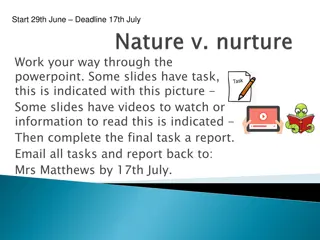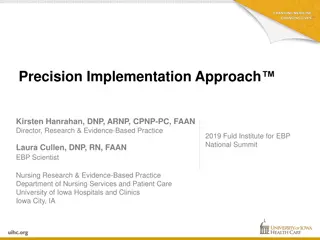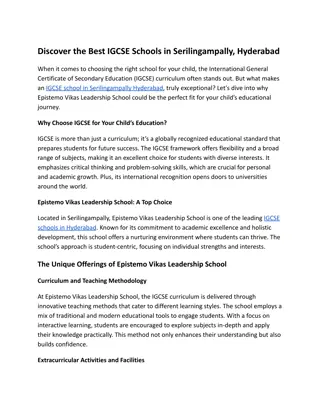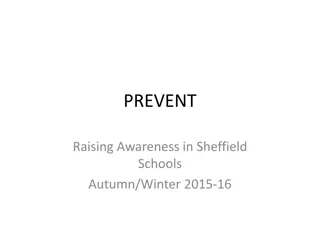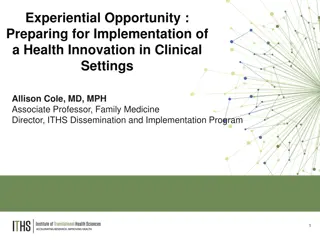Nurture Practice in Schools: A Guide to Implementation
Explore the essence of whole school nurture and the art of persuasion to promote wellbeing and relationships for children and young people. Discover practical tips on embedding nurture principles into daily practices and engaging staff effectively. Learn how to make your classroom a beacon of nurture while fostering a school-wide culture of support and growth.
Download Presentation

Please find below an Image/Link to download the presentation.
The content on the website is provided AS IS for your information and personal use only. It may not be sold, licensed, or shared on other websites without obtaining consent from the author.If you encounter any issues during the download, it is possible that the publisher has removed the file from their server.
You are allowed to download the files provided on this website for personal or commercial use, subject to the condition that they are used lawfully. All files are the property of their respective owners.
The content on the website is provided AS IS for your information and personal use only. It may not be sold, licensed, or shared on other websites without obtaining consent from the author.
E N D
Presentation Transcript
WHOLE SCHOOL NURTURE And The Fine Art of Persuasion
At the heart of nurture is a focus on wellbeing and relationships and a drive to support the growth and development of children and young people Glasgow City Council website 2020 Essentially what you would hope most teachers go into the profession for in the first place! Based on this assumption, most of your staff team will already have some elements of Nurture embedded in their practice, even if they aren t aware of the fact. THIS IS THE WAY IN!
Where to start? It is a lot easier to get your staff team to embrace Nurture practice when they are reminded of it every day.
Where to start? A good starting point is the Six Principles of Nurture poster: Make sure every classroom, the staff room and corridor noticeboards are all adorned with it. Don t leave anyone out- give a copy to the school kitchen and the caretaker too. Ensure that there is a poster at the point where staff and visitors first enter the school: if it s the first thing they see, they are more likely to associate the school with Nurture and Nurture practice. It is vital that staff/ SLT start to view Nurture as something which every person in school has a stake in/ is part of on a daily basis, rather than just something isolated that certain difficult learners do (see mollycoddling & basket-weaving ).
Where to start? Deliver a PSHE lesson on the six principles to your group/ class. Ask them to create a poster, putting the principles into their own words. Colour copy these posters and put them around school too. Offer your six principles lesson plan to your colleagues to deliver with their own classes.* *Deliver your lesson first, however. That way, you can show colleagues the resources your class have created. (Sell it to the reluctant as a simple way to display examples of pupil voice in their classroom!)
Making your classroom a Beacon! It may be that your school already has a Nurture space or room. Obviously this is good practice, and is excellent for giving the learners a sense of routine and security, as well as all of the other benefits that Nurture practice brings HOWEVER it can have the unfortunate side effect of allowing staff and SLT to compartmentalise Nurture and view it as something separate to the rest of the school, as opposed to being embedded within it. Counter-balance this by visibly embedding Nurture into your everyday practice as well as on a discrete basis
Making Your Classroom a BEACON! The big message we re selling here is: Nurture benefits all. If you can show the benefits for all learners and staff through your classroom practice and environment, colleagues are more likely to adopt Nurture principles. Convincing SLT can be a longer-term proposition and getting several classes engaged with the idea of whole school nurture will allow you to showcase the benefits on more than one front. Using whole school Nurture strategies at less-structured times of the day is also a simple and highly visual way of illustrating the positive benefits of the Nurturing approach.
Nurture in the Classroom: Consider the following ideas Mood boards by the classroom door: These give you an at a glance idea of the temperature of your class, as well as adding routine and predictability. An Expect The Unexpected board on the wall outside the class: *Or at the school door, if possible- this will make the strategy more immediate and also allows other members of staff, learners and parents to see it in action. A rigid entry and exit procedure, which follows the same pattern every day:
Nurture in the Classroom: Consider the following ideas All transitions being similarly fixed and predictable. Visual timetables on all tables/desks. Structured whole-class brain-breaks Low level music playing throughout the day. Philosophy 4 Children as an activity to start each day.
Whole School Approach: Make it visible! Involve parents: Send a letter home explaining about Nurture practice and why it is used in your class/school. Include a copy of the six principles poster and a copy of their child s own interpretation of the principles (the poster they created in the PSHE lesson). Peer assessment: Allow your colleagues to observe a lesson where Nurture is key, ensure they see the beginning of the lesson so they can see any transitional processes. Offer to observe them, with the focus being Nurture. Identify all of the things they are already doing and offer some easy Nurture wins. Share your work: Set up a central Nurture folder in your school s shared documents area, rather than saving it in your own area. Put all of your Nurture strategies, resources, and assessment docs in there. Sell it as a shared, whole-school resource. Mention it at briefings and meetings. Spread the word: Offer to deliver an introduction to Nurture CPD session at inset. Get Nurture content onto the school website and social media platforms, as well as the school newsletter.
Convincing SLT.. Get a copy of the assessment criteria tick-sheet for the National Nurturing Schools Award. Do a schools audit and tick off what you are already doing: I guarantee that you will already be doing much more than you think you are. Share with SLT. Look at your school policies and refer back to the tick-sheet. Again, note how and where Nurture is mentioned and highlight the areas it covers on the assessment criteria. It is easier to encourage your school to be involved in whole-school nurture if they are already doing 60% of it without having realised! Complete the Halton Nurture Network self-assessment document- this will give you both a percentage score of how nurturing your school is and next steps to develop your Nurture practice (We ll be talking about this later in the meeting!)
Ideas for HBC Nurture Group? Could we produce a promotional video showing what Nurture looks like and how it has made a difference in our schools? Could we produce a Halton Nurture Guide for school governors? Could we create a Halton Nurture Network website, which we can use to share exchange and gather resources?
Dont Give Up! All steps, no matter how small or slow, are all steps in the right direction. Share your successes. Lean on your Nurture colleagues- the Halton Nurture Network is a brilliant source of support! Ask Ami- her visits, advice and liaison with schools can have real impact.
Thank you! Martyn.Jowett@thebridge.halton.sch.uk




